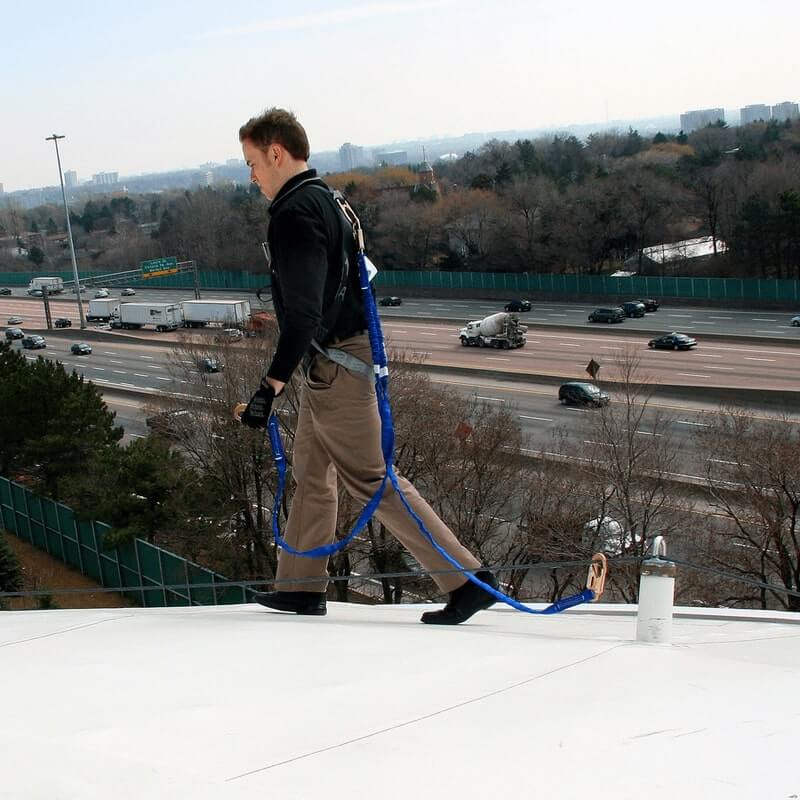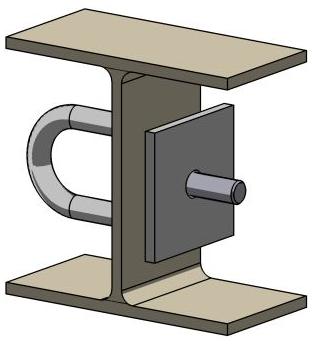The selection of proper roof anchors is critical and requires an in-depth knowledge of fall window washing, suspended maintenance, fall protection codes, standards and rigging methods. Additionally, recognizing that each building is unique, most architects, developers, and general contractors find it daunting to select a professional roof anchor company. This blog outlines the essential standards and best practices for designing roof anchors for reliable fall protection.
Pro-Bel offers a free design service for fall protection systems
Lifelines
A standard lifeline is 5/8 inch (1.59 centimetres) in diameter and has a breaking strength of 5,000 pounds (2,267.96 kilograms). However, tying off to an anchor using a knot in a rope can reduce its strength by 50% (or more) due to the cutting action of the lifeline or lanyard.
Therefore, good design must ensure that the anchor eye is greater in diameter than the rope itself. The proper anchor eye for a possible knot connection is 3/4 inch (or 1.9 centimetres). This design principle ensures the anchor eye will not cut, damage, or weaken the rope.

Flat Plate Anchors
Special caution should be noted when considering a flat thin plate anchor. These anchor designs are intended to use a snap hook or D-ring connection. However, the rope is more likely to sever and fail if a knot is tied to these anchors.
D-Rings and Snap Hooks
D-rings and snap hooks are designed with a minimum tensile strength of 5,000 pounds (2,267.96 kilograms). They shall be proof-tested to a minimum tensile load of 3,600 pounds (1,632.93 kilograms) without cracking, breaking, or suffering permanent deformation.
Other problematic compatibility issues include the use of non-locking snap hooks or D-rings that are incorrectly sized and incompatible with the anchor’s diameter and/or inside dimension. Relative to the snap hook, these incompatible dimensions will cause the connected object to depress the snap hook keeper and release unintentionally.
Forged Eye Bolts: Limitations and Best Practices
Eye bolts are rated along the axis of the bolt, and their strength is significantly reduced if the force is applied at an angle to this axis in the direction of the shear.
Generally, rollout can be done with small eyebolts measuring 1/2 inch (1.27 centimetres) or 5/8 inch (1.59 centimetres). These eyebolts are also too rigid, so when put to a fall arrest test, they will damage the securement stud and cannot be designed with redundancy. They are too small and should not be used in a fall arrest system.
Additionally, it should be noted that forged eyebolts, non-shoulder eye bolts, and shoulder eye bolts are not designed or approved by the manufacturer as life safety products. These anchors are designed for vertical loading, not angled loading. Additionally, because forged eye bolts are rigid, the securement bolt is almost always damaged under test loads or under cyclical normal-use conditions.
A hook must be compatible when the diameter of the anchor to which the snap hook is attached is greater than the inside length of the snap hook when measured from the keeper’s bottom (hinged end) to the inside curved top of the snap hook. Thus, no matter how the D-ring is positioned or moved (rolled) with the snap hook attached, the D-ring cannot touch the outside of the keeper, thus depressing it open.
The 5,000-Pound Rule: Understanding Safety Standards
The design rule is that a 5,000-pound (2,267.96 kilograms) fracture or pull-out is sufficient to accept all tie-back and lifeline loads that are likely to be applied to the anchor using conventional rooftop equipment.
The anchor eye, base, or base plate should accept this energy and load, not the securement studs, to support a worker in the event of a fall. The codes state that the 5,000 pounds (2,267.96 kilograms) is based on a worker weighing 250 pounds (113.4 kilograms) and experiencing a force of gravity multiplied by a safety factor of 2.
250 x 10= 2,500 x 2= 5,000 pounds
While the energy-absorbing lanyards can hold more than 5,000 pounds (2,267.96 kilograms) when fully extended, most limit the load during a fall to under 1,250 pounds (566.99 kilograms).
Ensure Your Roof Anchors Meet Safety Standards


